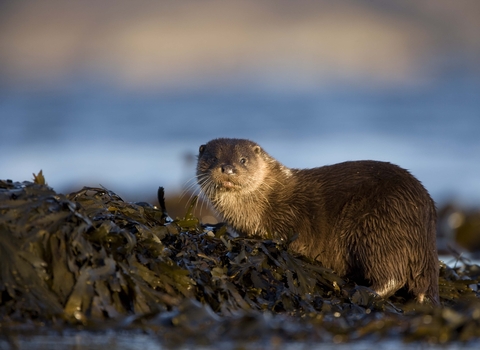
©Danny Green/2020VISION
Dyfrgi Ewropeaidd
Mae’r dyfrgi hyblyg yn nofiwr ardderchog a gellir ei weld yn hela mewn gwlybdiroedd ac afonydd ac ar hyd yr arfordir – rhowch gynnig ar arfordir gorllewinol yr Alban, Gorllewin Cymru, y West Country neu Ddwyrain Anglia am y golygfeydd gorau.
Enw gwyddonol
Lutra lutraPryd i'w gweld
Ionawr i RhagfyrGwybodaeth am rywogaethau
Categori
Ystadegau
Length: 60-80cmTail: 32-56cm
Weight: 6-8kg
Average lifespan: 5-10 years
Rhywogaeth Ewropeaidd a Warchodir o dan Atodiad IV o'r Gyfarwyddeb Cynefinoedd Ewropeaidd. Wedi'i restru fel Agos At Fygythiad ar Restr Goch fyd-eang IUCN o Rywogaethau Dan Fygythiad.
Ynghylch
Mae’r dyfrgi swil yn un o’n prif ysglyfaethwyr ni, yn bwydo’n bennaf ar bysgod (yn enwedig llysywod ac eogiaid), adar dŵr, amffibiaid a chramenogion. Mae dyfrgwn yn geni eu cenawon mewn tyllau tanddaearol, o’r enw 'gwalau'. Yn nofwyr ardderchog a hyblyg, mae'r cenawon yn y dŵr yn 10 wythnos oed. Mae dyfrgwn yn addas iawn ar gyfer bywyd ar y dŵr gan fod ganddynt draed gweog, ffwr trwchus i'w cadw'n gynnes, a gallant gau eu clustiau a'u trwyn pan fyddant o dan y dŵr. Mae arnynt angen afonydd glân, gyda ffynhonnell helaeth o fwyd a digon o lystyfiant i guddio eu gwalau diarffordd.Sut i'w hadnabod
Mae'r dyfrgi yn famal mawr, pwerus, gyda ffwr llwydfrown, trwyn llydan, a brest a gwddw gwelw. Mae posib dweud y gwahaniaeth rhwng dyfrgwn a mincod oherwydd eu maint llawer mwy a'u hwynebau lletach.Dosbarthiad
Rhywogaeth brin ond eang, sydd bellach i'w chael ledled y wlad ond sy'n absennol o rannau o ganolbarth a de Lloegr, Ynys Manaw, Ynysoedd Sili ac Ynysoedd y Sianel.Roeddech chi yn gwybod?
Mae gweld arwyddion dyfrgwn yn llawer haws na gweld yr anifeiliaid eu hunain. Ar hyd glannau afonydd a dyfrffyrdd, chwiliwch am olion traed pum bys (tua 6 i 7cm o hyd) a baw neu dail. Mae dyfrgwn yn gadael tail mewn llecynnau amlwg, fel coed wedi syrthio, coredau a phontydd, fel 'negeseuon persawrus', gan eu helpu i ddod o hyd i gymar ac amddiffyn tiriogaethau. Mae’r tail yn cynnwys esgyrn pysgod gweladwy ac mae ganddo arogl nodedig, dymunol, sy'n atgoffa rhywun o de jasmin!Gwyliwch
Otter by Russell Savory (https://vimeo.com/348139878)
Russell Savory
